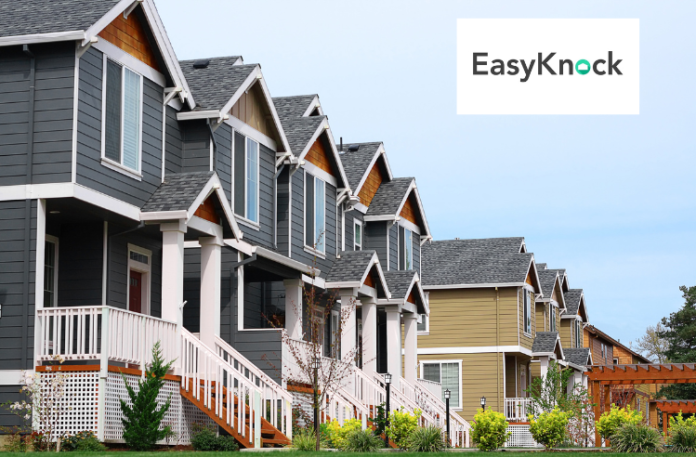As of the second quarter of 2023, the median home price in the U.S. was $416,100, according to the Federal Reserve Bank of St. Louis. This is a significant amount of equity for many homeowners, but it’s often inaccessible due to current lending standards.
In the aftermath of the 2008 financial crisis, the U.S. housing market underwent a significant transformation. Stricter lending standards emerged, designed to prevent another subprime mortgage meltdown. But these well-intentioned reforms, along with more recent rising interest rates and inflation, have contributed to an unexpected consequence: a growing cohort of “boxed-in” homeowners who find themselves asset-rich but cash-poor, unable to access the equity in their homes through traditional means.
In 2016, Jarred Kessler founded EasyKnock to offer a solution: residential sale-leaseback with an option to buy back. This approach aims to provide flexibility and liquidity to homeowners who have been left behind by conventional financial products. Can this model truly address the needs of middle-class Americans struggling with inflation, stagnant wages, and mounting personal debt?
The Boxed-In Phenomenon
According to a recent white paper by researchers Marvin Chang and Jeremy Potter, over 9 million American homeowners could be classified as boxed-in. These individuals have substantial equity in their homes but are unable to access it due to factors like an unaffordable housing market, insufficient income, less-than-stellar credit scores, or other constraints.
The paper notes that there are roughly 2 million mortgage holders with credit scores below 600, 3.2 million homeowners with long-term mortgages at interest rates of 6% or above, and 2.6 million homeowners over the age of 45 without steady income.
Kessler explains the crux of the problem: “After the credit crisis, lenders really started looking more at the person’s profile. One of the big reasons people get declined is their debt-to-income ratio is not in the right place.” This ratio, a key factor in mortgage underwriting, has become increasingly problematic as interest rates have risen and inflation has squeezed household budgets.
Many Americans are taking on more credit card debt at higher rates, hurting their credit scores and restricting their ability to save income and improve their debt-to-income ratio. According to an August 2024 Federal Reserve Bank of New York report, total credit card balances are up 5.8% from a year ago, to $1.14 trillion, and rates of credit card delinquencies are increasing.
“If interest rates go up, debt goes up and that ratio gets out of whack,” says Kessler. “A large percentage of homeowners in the U.S. do not have access to the mortgage markets, and it’s one of the big reasons you don’t see a lot of movement. They’re boxed in. Lower FICO scores are another big reason. Those are really the two driving factors that are boxing in people and we have record amounts of home equity.”
EasyKnock Solution
EasyKnock’s programs offer a potential lifeline to these boxed-in homeowners. Here’s how it works:
The company purchases a home directly from the homeowner at 100% fair market value as determined by an independent appraiser. The homeowner receives 75% of the purchase price in cash at closing, and the remaining 25% is held as an option contract, giving the homeowner the right to buy back the property or to direct a sale on the open market where they can realize all potential future appreciation. The former owner then becomes a tenant of the house, signing a one-year lease with the option to renew for up to five years, depending on the program.
This arrangement provides immediate liquidity while allowing the homeowner to remain in their house. It’s a stark contrast to traditional options like home equity loans or cash-out refinancing, which often remain out of reach for those with credit issues or insufficient income.
“We give people appreciation, we give people the chance to buy back their home, we’re paying their taxes, homeowners insurance, [homeowners association] fees, we’re handling some of the repairs. We’re giving people an opportunity,” says Kessler.
EasyKnock has also made efforts to keep the rental arrangement fair and transparent. It caps annual rent increases at the greater of 2.5% or the consumer price index, which stands in contrast to some landlords who have implemented dramatic rent hikes in recent years.
Kessler also emphasizes the sell-leaseback model isn’t meant to be a permanent solution, but rather a bridge to help homeowners regain their financial footing.
“If we’re not seeing them again, it’s a good thing,” he says, noting that many customers use the program to pay off high-interest debt or weather temporary financial difficulties before repurchasing their homes.
The Broader Economic Context Going Forward
EasyKnock’s emergence comes at a time of significant economic uncertainty. With inflation pressures persisting, many middle-class homeowners find themselves in precarious financial positions. A lack of financial cushion makes accessing home equity all the more critical for many families.
“A few years ago, somewhere around 50% of the country couldn’t afford an unexpected bill of $1,000 or more, and I bet you it’s now $500,” Kessler says.
The company’s focus on the middle class is deliberate and, Kessler argues, necessary. “I think a lot of people are trying to serve the upper echelon and I think the people that need the most help are the middle class,” he says. “When you’re rich, there’s a lot of choices and when you’re in the middle class, there are not a lot of choices.”
Looking ahead, Kessler sees both opportunities and potential pitfalls in the housing market. He anticipates a potential increase in foreclosures and believes that, as interest rates eventually decline, it could drive up home prices in some areas while leading to repricing in others.
“I think you’re going to see more so than any other period, a discrepancy throughout the United States of some markets that are doing really well versus markets that are doing really bad,” he cautions.
As the 2024 U.S. presidential election approaches, housing affordability is emerging as a key issue. Kessler sees this as both an opportunity and a challenge. “Affordability is the sleeper issue of the campaign this year,” he believes.
However, he’s also wary of how the issue might be politicized. “The biggest problem is the middle class, and people struggling with income are too often used as pawns in these elections,” Kessler says. He argues for more concrete action: “If you really want to help these people, you should encourage incentives to help them.”
Find a Home-Based Business to Start-Up >>> Hundreds of Business Listings.

















































